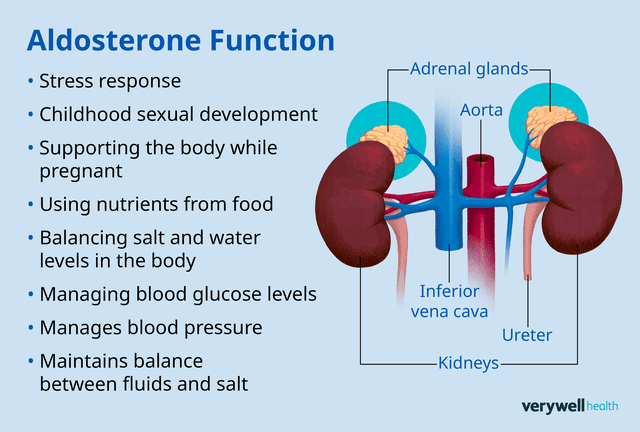Aldosterone Function and Signs of Imbalance
Medically reviewed by Isabel Casimiro, MD, PhDMedically reviewed by Isabel Casimiro, MD, PhD
Aldosterone is one of the hormones made by the adrenal glands, a pair of internal organs that sits just above your kidneys.
This hormone performs several important functions, including helping to regulate your blood pressure and balance the levels of two electrolytes, sodium and potassium, in your body. If your body produces too much or too little aldosterone, you may experience high or low blood pressure, fluid retention, or symptoms related to an electrolyte imbalance.
This article discusses the role of aldosterone in the body, as well as symptoms of an aldosterone imbalance, treatment options for aldosterone disorders, and more.

Illustration by Mira Norian for Verywell Health
Aldosterone Function and Adrenal Roles in Body
Hormones like aldosterone act as messengers that tell your body how and when to perform key functions. These functions include:
Regulating the timing of childhood sexual development
Supporting the body in pregnancy
Using nutrients from food
Balancing salt and water levels in the body
Managing blood glucose (sugar) levels
Managing blood pressure
Aldosterone manages your blood pressure and maintains the delicate balance between fluids and salt by regulating your sodium and potassium levels. That’s why people with an adrenal disorder that causes too much or too little aldosterone may experience irregular blood pressure levels or fluid retention.
Production of Aldosterone
Overproduction or underproduction of aldosterone may have many different causes. Some of the possible reasons for excessive aldosterone production include:
Certain health conditions, such as Bartter syndrome, liver cirrhosis, or primary hyperaldosteronism (too much aldosterone)
Laxative and/or diuretic abuse
Heart failure
Extremely low sodium intake
Certain medications, especially mineralocorticoid antagonists (blood pressure medications)
If your adrenal glands don’t produce enough aldosterone, potential causes include:
Extremely high sodium intake
Adrenal gland disorders, such as Addison’s disease or Cushing’s syndrome
Adrenal gland tumors (either benign or cancerous)
Kidney disease
Diabetes
Lead poisoning
Certain medications, such as heparin and nonsteroidal anti-inflammatory drugs (NSAIDs)
Symptoms of Aldosterone Imbalance
Aldosterone imbalances include hyperaldosteronism and hypoaldosteronism (not enough aldosterone).
Symptoms of hypoaldosteronism include:
High potassium levels
Hypotension (low blood pressure)
Lethargy
Low appetite
Low sodium levels
Stomach pain
Unexplained weight loss
Weak muscles
Meanwhile, symptoms of hyperaldosteronism may include:
Arrhythmia (abnormal heartbeat)
Fatigue
Frequent urination
Headaches
High sodium levels
Hypertension (high blood pressure)
Low potassium levels
Muscle cramping
Spasms
Thirst
Treatment Options for Aldosterone Disorders
Treatment for hypoaldosteronism often starts with salt and fluid therapy. To treat your symptoms, your healthcare provider may prescribe mineralocorticoids. The first-line treatment is Florinef (fludrocortisone).
Hyperaldosteronism is sometimes treated with a type of diuretic known as mineralocorticoid receptor antagonists (MRAs), such as Aldactone (spironolactone). Limiting salt intake can also help. If other ways of lowering aldosterone levels fail, your healthcare provider may recommend that you undergo an adrenalectomy, a type of surgery to remove one or both of the adrenal glands.
If your symptoms are related to an underlying condition, such as diabetes, taking steps to treat that condition could help to relieve your aldosterone imbalance. You may also need to take medication to control your blood pressure.
Managing Your Blood Pressure
If you have an aldosterone disorder, it’s especially important to take steps to manage your blood pressure. Examples include:
Quitting smoking
Limiting your intake of alcohol, salt, and caffeine
Exercising regularly
Prioritizing sleep
Managing your stress
Eating a heart-healthy diet rich in fruits, vegetables, protein, and whole grains
Avoiding processed foods and sugary beverages
Summary
Aldosterone, a hormone produced by the adrenal glands, helps to regulate blood pressure, balance electrolytes, and maintain healthy fluid retention.
Symptoms of hypoaldosteronism, too little aldosterone, include low blood pressure, appetite loss, fatigue, and unexplained weight loss. Meanwhile, hyperaldosteronism (excessive aldosterone) may cause symptoms like high blood pressure and excessive sodium levels, combined with low potassium. Treatment may include lifestyle changes to manage blood pressure, as well as prescribed medications and surgery to remove the adrenal glands if needed.
Read the original article on Verywell Health.

